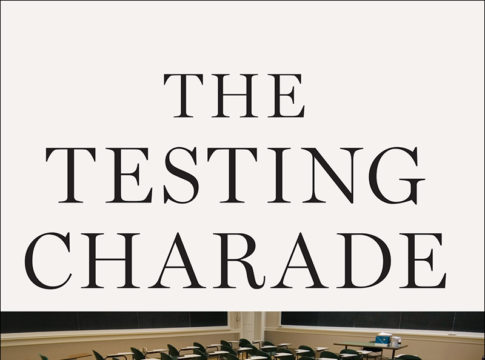 Grading Education: Getting Accountability Right
Grading Education: Getting Accountability Right
By Richard Rothstein, Rebecca Jacobsen and Tamara Wilder
Economic Policy Institute and Teachers College Press, 2008, $19.95; 263 pages.
As reviewed by Chester E. Finn Jr.
Some may take this wrong-headed book seriously, given the credentials of lead author Richard Rothstein, former New York Times education columnist, all-around smarty, and veteran maneuverer on the education-policy chessboard. Its timing is deft, too, as it savages the federal No Child Left Behind Act (NCLB) and offers recommendations for its overhaul (overthrow, really) just as a new administration and Congress face itsreauthorization.
Rothstein and a pair of junior colleagues advance three central theses, all of which are wrong—though they’ll appeal to a strange alliance of progressive educators and (up to a point) conservative Republicans.
First, and most NCLB-relevant, “We should get the federal government out of the business of monitoring education at the school or student level.” But it’s not just Uncle Sam who should quit judging performance by students (and schools and districts) via “short-term test score measures of basic skills.” So, too, should the states. The authors view all such accountability measures as agents of educational corruption.
That’s because, thesis two, education has in their judgment eight “fundamental goals,” of which “basic academic knowledge and skills in reading, writing, math, science and history” are but one. The others include physical and emotional health, social skills, work ethic, appreciation of the arts, and community responsibility. These are equally important, insist the authors, and must all be incorporated into any self-respecting accountability system.
Third, they want NAEP, the National Assessment of Educational Progress, rolled back to a reporting system that contains no standards or cut scores, only a numeric scale that nobody understands. At the same time, they would widen its subject coverage to span all eight “fundamental goals,” employing “performance assessments” of various sorts to appraise progress in areas unsuited to paper-and-pencil testing.
This is not just wrong-headed; it’s dangerous. It plays into the hands of union-backed efforts to exonerate schools from responsibility for student achievement. It aligns with a faction within the Democratic Party (and some key Obama advisors) as they seek to gut standards-based reform in general and NCLB in particular. It also appeals to the yearning of some GOP lawmakers and libertarian policy wonks to get Uncle Sam completely out of the school-accountability business (though they’ll gag on Rothstein’s demand for buckets more in federal dollars for those unaccountable schools and sundry other services to kids). And it would leave educators, policymakers, and parents with fewer navigational aids as they try to determine whether American students and schools are making progress in a competitive world.
It’s true that NCLB’s laser-like focus on reading and math skills in grades 3 through 8 encourages schools to concentrate their resources and teachers their energies on those subjects. It’s also true that the law’s use of a single proficiency “cut score” to judge school performance discourages attention to kids who are already succeeding—and those so far below proficiency as to have little chance of getting there. Dozens of other NCLB critics have reached similar conclusions, and scads of proposals for that law’s rewrite offer remedies, such as including more subjects in the accountability system and giving schools credit for student growth across the achievement spectrum.
Rothstein is correct, as well, that NCLB’s reliance on states to define “proficiency” however they like has produced wildly discrepant results across the land. (It escapes me why he then urges that states be placed in sole charge of school standards and accountability with no federal involvement at all.) But he draws a bizarre link between that problem and his scorn for NAEP’s achievement levels, wrongly asserting that the National Assessment Governing Board’s decision to fix the “proficient” level at an ambitious “aspirational” level was folded into NCLB’s mandate to states to set their own proficiency targets. That’s crazy. Had Congress and the White House had the political guts in 2001 to use NAEP, rather than states’ own inconsistent standards, as the primary No Child Left Behind benchmark, we’d have avoided some of today’s woes, including the paltry aspirations promulgated by many states.
The authors’ misunderstanding of NAEP is comprehensive, however, as is the harm that would be done were it to be reshaped to their liking. They yearn for a NAEP-that-never-was, rattling on for 20 nostalgic pages about the glories of a 45-year-old plan prepared by a high-status committee of educators chaired by the late Ralph Tyler, most of which was ignored from day one by Congress, the executive branch, and the National Assessment Governing Board.
Rothstein ardently dislikes the board’s execution of a 1988 statutory mandate to establish “appropriate student performance levels for each age and grade in each subject area to be tested” under the National Assessment. (That’s the correct language; Rothstein misquotes it.) The board, on which I served for eight years and chaired for two (though Rothstein also misstates how I got there, apparently not knowing that board members are appointed by the secretary of education, not the president), after gathering extensive advice from every quarter, opted to set three such levels and to designate the second of those “proficient.” After gathering tons more advice as to what method to use for applying those levels to actual assessments, the board settled on a process named (sorry about this) the “modified Angoff method.” And to make a long story short, the terminology, the method, and the changed way of reporting NAEP results have been under fire ever since from analysts and educators, even as they’ve gained traction in the real world.
Those performance levels turned out to be as useful to policymakers, parents, and journalists—a true gauge of student progress at the state and national levels, the closest America has yet come to any sort of national standards—as they are unloved by some experts. Note, though, that critics such as Rothstein never suggest a better way of setting such levels. They just don’t like this one, or don’t want any standards in the first place, preferring the inscrutable “scale score” reporting system that renders no judgments about “how good is good enough.”
If the authors were to prevail, NAEP would become blurry and weak, standards-based reform would nearly vanish, and NCLB would be undone rather than revamped. Let us hope that right-thinking people, encouraged by this review, will see the errors of Rothstein et al. and opt to ignore them.
Chester E. Finn Jr. is president of the Thomas B. Fordham Foundation and senior editor of Education Next.





